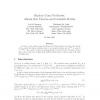36 search results - page 3 / 8 » Countably Complementable Linear Orderings |
COLING
2002
13 years 7 months ago
2002
We present a quantitative model of word order and movement constraints that enables a simple and uniform treatment of a seemingly heterogeneous collection of linear order phenomena...
RSA
1998
13 years 7 months ago
1998
Let Un,p be the random unary predicate and Tk the almost sure first-order theory of Un,p under the linear ordering, where k is a positive integer and n−1/k p(n) n−1/(k+1) . F...
EJC
2008
13 years 7 months ago
2008
Abstract. A pattern class is a set of permutations closed under pattern involvement or, equivalently, defined by certain subsequence avoidance conditions. Any pattern class X which...
CORR
2010
Springer
13 years 7 months ago
2010
Springer
Orbits of graphs under local complementation (LC) and edge local complementation (ELC) have been studied in several different contexts. For instance, there are connections between...
JSYML
2006
13 years 7 months ago
2006
Levin and Schnorr (independently) introduced the monotone complexity, Km(), of a binary string . We use monotone complexity to define the relative complexity (or relative randomnes...

